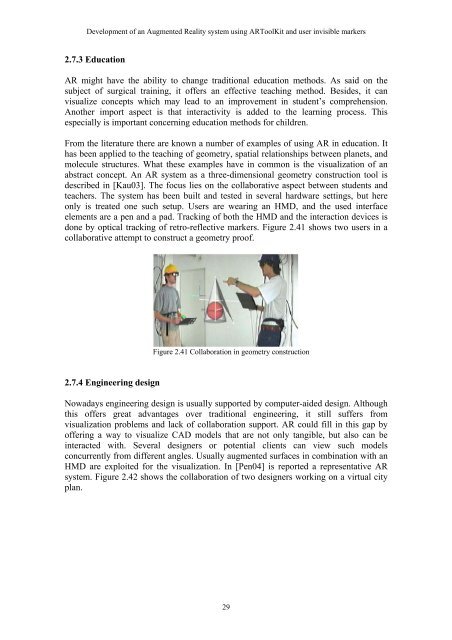Development of an Augmented Reality system using ARToolKit
Development of an Augmented Reality system using ARToolKit
Development of an Augmented Reality system using ARToolKit
Create successful ePaper yourself
Turn your PDF publications into a flip-book with our unique Google optimized e-Paper software.
<strong>Development</strong> <strong>of</strong> <strong>an</strong> <strong>Augmented</strong> <strong>Reality</strong> <strong>system</strong> <strong>using</strong> <strong>ARToolKit</strong> <strong>an</strong>d user invisible markers<br />
2.7.3 Education<br />
AR might have the ability to ch<strong>an</strong>ge traditional education methods. As said on the<br />
subject <strong>of</strong> surgical training, it <strong>of</strong>fers <strong>an</strong> effective teaching method. Besides, it c<strong>an</strong><br />
visualize concepts which may lead to <strong>an</strong> improvement in student’s comprehension.<br />
Another import aspect is that interactivity is added to the learning process. This<br />
especially is import<strong>an</strong>t concerning education methods for children.<br />
From the literature there are known a number <strong>of</strong> examples <strong>of</strong> <strong>using</strong> AR in education. It<br />
has been applied to the teaching <strong>of</strong> geometry, spatial relationships between pl<strong>an</strong>ets, <strong>an</strong>d<br />
molecule structures. What these examples have in common is the visualization <strong>of</strong> <strong>an</strong><br />
abstract concept. An AR <strong>system</strong> as a three-dimensional geometry construction tool is<br />
described in [Kau03]. The focus lies on the collaborative aspect between students <strong>an</strong>d<br />
teachers. The <strong>system</strong> has been built <strong>an</strong>d tested in several hardware settings, but here<br />
only is treated one such setup. Users are wearing <strong>an</strong> HMD, <strong>an</strong>d the used interface<br />
elements are a pen <strong>an</strong>d a pad. Tracking <strong>of</strong> both the HMD <strong>an</strong>d the interaction devices is<br />
done by optical tracking <strong>of</strong> retro-reflective markers. Figure 2.41 shows two users in a<br />
collaborative attempt to construct a geometry pro<strong>of</strong>.<br />
2.7.4 Engineering design<br />
Figure 2.41 Collaboration in geometry construction<br />
Nowadays engineering design is usually supported by computer-aided design. Although<br />
this <strong>of</strong>fers great adv<strong>an</strong>tages over traditional engineering, it still suffers from<br />
visualization problems <strong>an</strong>d lack <strong>of</strong> collaboration support. AR could fill in this gap by<br />
<strong>of</strong>fering a way to visualize CAD models that are not only t<strong>an</strong>gible, but also c<strong>an</strong> be<br />
interacted with. Several designers or potential clients c<strong>an</strong> view such models<br />
concurrently from different <strong>an</strong>gles. Usually augmented surfaces in combination with <strong>an</strong><br />
HMD are exploited for the visualization. In [Pen04] is reported a representative AR<br />
<strong>system</strong>. Figure 2.42 shows the collaboration <strong>of</strong> two designers working on a virtual city<br />
pl<strong>an</strong>.<br />
29
















